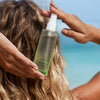First things first – all skin types are completely natural. Yours is an innate part of you that won’t suddenly change overnight, and it shouldn’t. That being said, we know that sometimes life in our bodies isn’t always going to be perfect. While our skin types stay the same, our skin’s day-to-day can be full of unpredictable moments or recurring patterns we don’t love, whether it’s the weather or a change in environment that’s having an impact. That’s what our Glow Academy series is here for; to give you the tools to understand your skin type, what’s affecting it, and how to help it to look and feel its very best.
We’re taking a look at Combination skin, the dual-natured skin type in search of a spot of balance. Don’t worry, you don’t have to buy double the beauty products!
So, what exactly is combination skin?
Surprise, surprise! Having combination skin means… having a combination of skin types (did you see that one coming?). Generally, individuals with this skin type will experience that some areas of their face are oily, while others are dry. It’s usually the case that they have slight to very oily skin on their T-zone (the forehead, nose and chin) and dry skin around the cheeks and jawline. There’s no ‘one size fits all’ approach, however. Distribution of oily to dry areas can be completely different from person to person, and it’s even been known for the traditional cheeks vs T-zone / oily vs dry dichotomy to occur the opposite way round.
There are some tell-tale signs of a combination complexion to keep on your radar. Pore size can be a giveaway, as you’ll commonly notice larger pores on the nose than the cheeks, and if you cleanse your face, wait for an hour and notice a clear disparity in oily and dry areas already, it’s likely that you have combination skin.
What can have an impact on combination skin?
This skin type can have a flair for the dramatic, but often its seemingly out-of-nowhere mood swings are actually the result of simple hormonal shifts in the body. Lifestyle factors like stress levels or diet (particularly one rich in processed foods) can send hormones on a rollercoaster ride and increase sebum (oil) production, as can natural biological processes like puberty and the menstrual cycle. Menopause can send combination skin in the opposite direction – skin produces far less oil during this stage of life, so your dry patches will be more noticeable.
With the changing of the seasons also comes a pendulum shift in your skin states. Facing the blustery chill of a British winter? ‘Tis the season for dry patches, as skin can grow dehydrated and stripped of natural oils, especially with the drying effects of that all-important central heating. Stepping out into the summer heat? Those humid July days are like a green ‘go’ light to your oily areas, as high temperatures naturally cause skin to produce more sebum.
Something as simple as not having a regular routine with go-to products you come back to time and again can really impact combination skin too. With so much great skincare out there, it’s only natural to want to try it all. But with a skin type that can already experience confusion, a constant stream of new products can compromise your skin’s barrier function, especially if you’re using ones with harsh ingredients that may have a stripping effect on oily areas. This paradoxically ends up causing the skin to overcompensate by producing even more oil.
How do I take care of combination skin?
- Moderation is the word of choice when it comes to looking after combination skin. Go for a simple routine made up of basics formulated with gentle actives (a mild cleanser, alcohol-free toner and a moisturiser that isn’t too heavy) along with some targeted masks and natural serums. This ensures that too much focus on dealing with dryness or oiliness individually doesn’t cause skin to boomerang in the other direction.
- During periods where hormonal changes are impacting combination skin, exercise acts as a regulator that can have major benefits. Regularly working activity into your day, even if that’s just a brisk walk, eases stress levels, helps improve circulation and stimulates endorphin production, keeping your body (and in turn, your skin) at a healthy balance. So dust off those shoes, pop in your headphones and hit the cobbles!
- Pay attention to what your skin is telling you, and don’t be afraid to tweak your routine to suit. Having a solid foundation of daily products to start from is step one, but at times when you’re noticing dryness take centre stage, for example, counterbalance it by reaching for a toner a few more times during the day to keep moisture levels topped up. Work on layering your products so that different areas are getting what they need, i.e. using a lightweight serum on oily areas and a hydrating mask on dry patches.
- Speaking of hydration, a regular dose of H₂0 is just the tonic combination skin needs to maintain a healthy glow. We know you’ve heard it a thousand times, but it bears repeating – try to drink between six to eight glasses of water a day. It can help keep skin at an even keel by stopping excess oil production and preventing any dryouts.
- It’s always best to err on the side of caution and choose products suited to slightly sensitive skin, too. If dry skin makes up part of your skin story, you don’t want to contribute to it becoming irritated by stocking up on products rich in fragrance or alcohol. We recommend sticking to products that are non-comedogenic (they won’t clog pores) as they’ll be kind to the oily T-zone, which is prone to breakouts.
Which ingredients are good for combination skin?

Look out for skincare which features..
Niacinamide (aka vitamin B3) – This ingredient sent from the skincare gods evens out skin tone and regulates sebum production, while strengthening skin’s moisture barrier.
Exfoliating acids – Keep an eye out for products containing polyhydroxy acids in particular (PHAs), as these are fairly mild while still helping to smooth out skin texture.
Hyaluronic acid – Flooding the skin with moisture without causing it to feel greasy, it finds the perfect middle ground between hydrating dry patches and keeping oiliness at a minimum.
The combination skin FAQ
Is aloe vera good for combination skin? Packed with antioxidants and vitamins, aloe vera’s made a name for itself as a soothing saviour that works its magic especially well on dry skin. That makes it a natural fit as an ingredient perfectly primed to help ease combination skin concerns.
Is double cleansing good for combination skin? Double cleansing can be a real boon for the oiliness that comes with this skin type, as it helps to guarantee that any excess facial sebum is broken down and cleansed away. However, it’s essential that you opt for a gentle cleanser, free from sulphates or alcohol, as going back for round two with a stronger option can leave skin feeling tight and dry instead.
Should I use SPF with combination skin? We stick by the motto that SPF is always an essential, come rain or shine, but for those with oily areas, we know that finding the right match can be a struggle, as a lot of sun care brings an oily sheen along with its protective effects. When you’re shopping beauty, look for an ultra-light, oil-free option.

 Skincare
Skincare
 Sale
Sale
 Bestsellers
Bestsellers
 Makeup
Makeup
 Body Care
Body Care
 Men's
Men's
 Hair Care
Hair Care
 Mama & Baby
Mama & Baby












